
HOW I FOUND #346 AND HOW SHE ENDED UP IN THE UK
By D. A. Wilson
Like so many vintage synth enthusiasts I had never heard of the Novachord up to only about a year ago. In fact, I stumbled across the instrument whilst searching for information about the 1920's RCA Theremin. Having restored a number of tube amps and radios, I had it in my mind that I wanted to combine my love of vintage electronics with a my obsession for collecting and restoring vintage synths. Like so many others, I was left speechless when I discovered Phil Cirocco's website and the truly incredible wonders of his rebuilt Novachord.
As an electronic design engineer, I really did both feel his want and drive to return such a unique monster to life but at the same time I totally appreciated the hell he must have gone through at times during that project!
It was from this point onwards I became obsessed with the Novachord and I started researching this beast in quite some detail. During my research I discovered Marc Doty's delightful video introduction to the Novachord on Sonic State as part of the Top 20 Weirdest Instruments Series. I was a regular visitor to the excellent forum attributed to Vintage Synth Explorer and one day, quite by accident, I discovered that Marc Doty (aka AutomaticGainsay) was also a regular contributor. The amazing twist in the tale is that Marc actually wrote to me in a moment of heated frustration as I'd upset him by passing some throw away comments about something or other. I apologised and then a further exchange of emails resulted in him noting that I live just down the road from where the Novachord video was editted in Bath, England for Sonic State! We got chatting and he told me that tragically this poor old instrument had attempted to burn his house down after being left unattended whilst running not so long after the video was released on Sonic State. Marc had made some enquiries into reviving number 346 but eventually it ended up in storage. I explained that I would love to take on the challenge of attempting to return 346 to working order and it seems that being an electronic engineer, a vintage synth enthusiast and residing in the country Marc and his English girlfriend shares a passion for was enough to let Marc part company with his beloved but sadly burnt out beast.
This really was the beginning of a long and sometimes incredibly frustrating chapter in my life. Having made the deal I was left with the rather daunting task of working out how the hell I was going to ship a rare and quite fragile ¼ ton instrument the size of a baby grand piano 1/3 rd of the way round the planet across three seas from Seattle to Somerset, England without destroying it or my bank account! After ringing around countless shipping companies it rapidly became obvious that I had a big problem. In the end I got incredibly lucky and, through a colleague at work, I found a guy working for a commercial shipping company that was so interested in the instrument he engineered a door to door solution for me through a string of contacts.
Even with a shipping solution in place, I was still far from making this happen. It turned out that Marc's storage facility was on the other side of Washington state. Furthermore, I was going to have to get a custom shipping crate built to safely move the beast in. I managed to find a custom crating company in Spokane and after much searching on the internet I found another Novachord owner that was able to make several measurements for me. A superb heavyweight crate was constructed and after much preparation Marc very kindly drove from Seattle to Spokane, picked up the instrument in a rented pickup and delivered it to the crating company and waved goodbye to #346 and a new chapter in its 70 year long life.
A few days later the crate, now full of Novachord and weighing 780lbs, was picked up by the shipping company.
From this point on it was like my life stood still for weeks on end. There wasn't a day that went by where I wondered how the poor old beast was handling her voyage of several thousand miles by road and sea in a wooden box.
Finally, I received the email that she'd arrive in port in the UK and after tackling a whole raft of confusing paperwork and another horrible delay in customs she was finally on her final stretch to her new home.
The day she was to turn up must have been one of the longest days in my life. After weeks and weeks of waiting I could barely handle the last few hours and, as the day rolled on and darkness was starting to fall, I really was starting to wonder if it was all a dream. Then, just when I thought something had gone horribly wrong with the delivery, a large lorry appeared and a cheery driver popped out. We all walked round the back of the lorry and there it was - a huge wooden crate - a crate I'd seen in pictures several weeks before but there in the flesh. I felt almost sick with anticipation. The driver expertly moved the 780lbs crate off the back of the lorry like it was something weighing quarter of the weight, wished us the best of luck and drove off.
Well, there it was - a huge box waiting to be dismantled to reveal the contents....
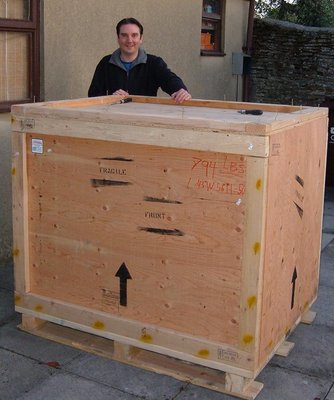
As darkness was drawing in ever rapidly my friend Patrick and I dashed to task with electric screwdrivers at the ready. We removed countless monster long screws and after a short while removed the top lid of the crate and with my heart in my mouth I peered inside. A few minutes later and we'd removed all five faces leaving her sitting on a super strong pallet. At this point I was just left standing there looking at a completely in tact but extremely dusty and rather scratched monster. The most amazing feeling of "oh my god what have I gotten myself into here!" crept over me. With light almost gone we madly determined how the Novachord famously came apart under torch light into its three constituent parts and we hauled them into the house piece by piece - and my god was it heavy!! The base section only just went through our patio doors on its side - literally with millimetres to spare!
So there it was in three pieces in the living room and absolutely full of polystyrene chippings...
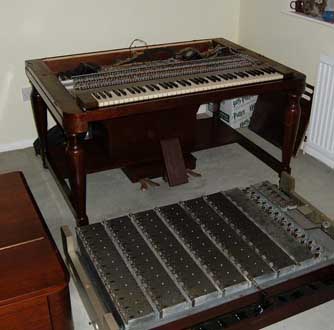
We spent hours picking these out between the beast's countless tubes in the generator chassis. They did their job though - there wasn't a single breakage and, amazingly, the instrument appeared to have not sustained any damage at all in transit with the exception of some of the tag strip supporting the 72 infamous keying springs on the back of the generator chassis breaking apart. Some careful gluing quickly sorted this out.
I spent the following day in a complete daze polishing everything to leave what tuned out to be an example in truly stunning condition for a 70 year old unrestored electronic instrument.
THE RESTORATION EFFORT
In many ways my experience with Novachord #346 has almost been diametrically opposite to Phil Circocco's valiant restoration project. What made Mr Cirocco's efforts all the more impressive is that he seemed to have taken on a particularly poor example, stripped it down to nothing more than a pile of tubes, tag strip and metal work and 100% rebuilt it with thousands of modern resistors, capacitors and metres of modern wiring.
Right at the other end of the scale, Novachord #346 quickly turned out to be in extraordinary original condition all things considered and completely intact. Even the wooden rear panel used to cover the PA and PSU chassis was present and I'm told this is extremely rare as there is a dire warning about running the instrument with the cover in place and hence it was more often discarded. It was a joy to see this in place complete with the original warning label.
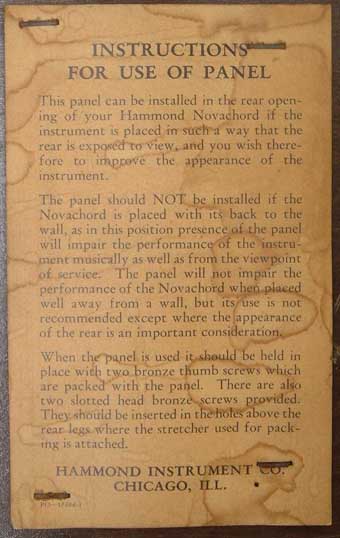
The operating instructions under the top lid are also present and in astounding condition considering they been mounted directly over the top of 146 potentially hot tubes for 70 years.
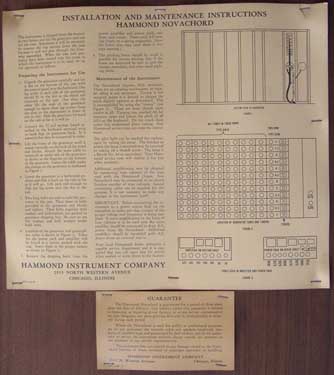
After meticulous inspection I came to the conclusion that Novachord 346 was in such uniquely good condition for its age that I decided very early on that I had a very rare opportunity to attempt to revive an instrument in almost 100% original condition. Very soon after setting this challenge, it dawned on me that here was a fantastically rare opportunity indeed to capture the original sound of a Novachord in such a state. From this point I decided to knowingly ignore everyone's cries of "you must replace all the passives in that thing!" and set about doing exactly the opposite!!
I must point out that the risks were carefully assessed and what was deemed safety critical was replaced. I labour this point because I can just imagine some chancers powering up lesser mortals in the vein hope they will work 100% unrestored. Please heed my words - this is a very BAD idea!
If you were to look inside my grandfather's desktop radio, which has been handed down through two generations of Wilsons from new in 1937 to over 70 years old in 2010, you'd quickly see why I was so surprised by the condition of #346. The inside of this radio is a disaster zone of tarnished metal, perished rubber and a collection of barely recognisable components haphazardly mounted on ceramic tag strips under tubes caked in baked on grime. It had spent over 50 years of its life in my grandfather's cold and damp house without central heating in West Yorkshire in the north of England. For the first few years of its life, it ran for hours on end every day barking out live wartime speeches by Winston Churchill whilst my father and uncle sat on the floor next to it listening intently.
In stark contrast, every time I wiped the dust and grime off each component and surface in the Novachord, I was confronted with brightly colour coded resistors, silver coloured metal capacitor casings, chrome plated rivots so shiny I could my face in them and remarkably untarnished and non-corroded galvanised metal chassis plates.
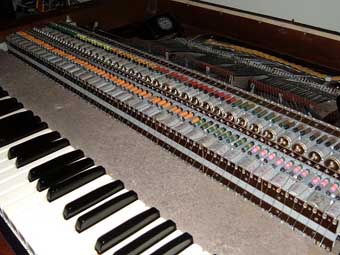
I was in total awe of this thing. I was pulling out great big bottle shaped tubes from their Bakelite octal sockets only to see shiny pins - most tubes that have been in sockets this long usually look like they've been on the bottom of the sea! The other thing was a very curious sensation that this design must have been absolutely cutting edge in 1939. You can just tell this by the style of construction more closely resembling something built 15 years later. It's also clear that money really wasn't that much of a concern when this was being built. Most consumer electronics of this era made use of horrifically unsafe transformerless designs with live chassis and horribly weak permanent magnet loudspeakers. The Novachord was a fully isolated design with three mains transformers and an impressive power amplifier with four directly heated power triodes and two large energised loudspeakers that must have produced enough sheer tube audio power to make an entire town hall's windows rattle in sympathy with the player!!
After days of polishing the internals of the main generator chassis in a state of shock, I moved onto looking at the rest of her. For a little while I'd clearly deluded myself that little was going to be required to restore this beauty to working order but the, as with all major restoration jobs, reality hit me between the eyes. I turned my attention to the PSU chassis which, from day one, was clearly the source of the copious amounts of smoke that filled Marc house one eventful day.On first inspection it looked like it had simply been running hot and so I set about making a bulb limiter safety rig to power up the PSU without frying it or myself in case of a major failure. It became apparent after a slightly nervous initial power up that something was seriously wrong. It was at this point that I decided to start removing connections to each of the two mains transformers on the chassis and discovered to my dismay that one of them had a dead short in its primary. I removed the transformer and opened it up. It was in a terrible state - I mean this thing must have been glowing dull red for minutes on end - it was like the transformer had been sitting in a fire grate!
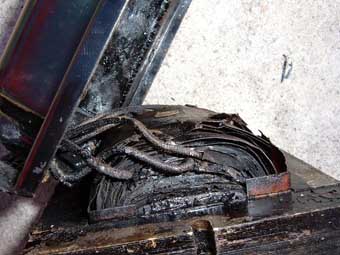
In hindsight I'm not even slightly surprised by this. It turns out that the Novachord had no internal fusing whatsoever - it seemed Hammond didn't approve of fitting fuses! This wasn't some heinous cost down exercise but rather a sign of the times when safety just wasn't considered the priority it is today. The original mains flex was further evidence of this as it was no more than two yellow cloth covered wires twisted together without a strain relief or earthing core. I removed the second HT transformer and to my dismay found that it was in a very similar state to the first. I then discovered that one of the HT rail suppression chokes was completely burnt out - more coal than copper!
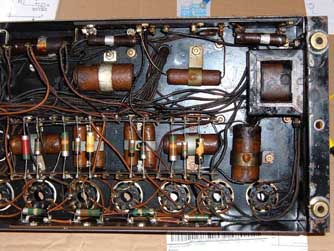
The following day, I discovered why this disaster had happened. One of the main bitumen potted decoupling multi-capacitors in the preamp channel was totally shorted out and it was this offending component had leaked molten tar all over the preamp channel chassis. This massively overloaded the power supply eventually rendering it a complete write off. Another day went by and I realised that there was no alternative - I was going to have to strip each and every component out of the PSU and completely rebuild it Phil Cirocco style. Even worse, in fact, as I was going to have to rebuild the transformers themselves!! After an hour or so of cutting a disgusting mess of sticky melted wax covered capacitors, burnt out resistors and tons of hideous gooey cloth covered wire which disintegrated as soon as you moved it I was left staring at a completely empty metal chassis in a state of bewilderment. I caught myself saying "what the hell have you done Dan!" but I had well passed the point of no return here!!
Being driven by absolute determination to hear that wonderful generator chassis make a sound, I set aside a clear week to pour nothing but sheer determination into rebuilding the PSU chassis. I stripped the chassis down, even removing the tube sockets and repainted it and baked it in the oven for several hours. I painstakingly dissected the mains transformers and determined their construction including measuring the wire gauges for each and every tapping. This turned out to be a nightmare as the Novachord's split rail PSU is an abnormally complex for a tube design. It generates 7 output voltage rails, two of which feature full active noise cancelling circuits that regulate to 500mVolts ripple at 270V DC!! The plethora of supply rails ranging up to plus and minus 270 Volts DC require transformers with loads of weird and wacky voltage windings and centre taps. It took me quite some time to reverse engineer these transformers to the point I could hand over the specification to a custom transformer specialist.
I had obtained an original service manual whilst waiting several weeks for my Novachord to be shipped 1/3 way round the world over two seas in a crate weighing 780lbs from Spokane, WA to Somerset, England via Houston. To my dismay, the schematics didn't contain enough detail to fully specify the two transformers or the choke which now needed to be custom built and so I had to reverse engineer them by calculating the loadings on each supply rail and pulling apart the remains of the transformers.
Having tasked a local custom transformer company with the challenge, I set about completely rebuilding the PSU chassis with safe modern equivalents of all the capacitors, resistors and wiring.
After several days of extremely intense work, I had finished everything apart from fitting the new transformers which were due soon. When they eventually arrived I was delighted to see that they were so close to the originals that the metal end bells from them fitted and they simply slotted into place on the chassis!
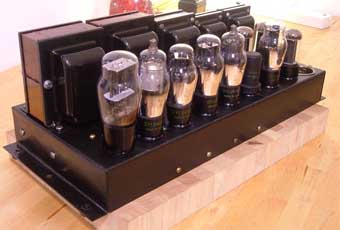
After a further day of wiring the transformers and replacement choke into the rest of the PSU chassis, I was perilously close to powering up the PSU for the first time. After some careful checks, I applied power to the PSU and to my delight, up she came with all output voltages running to spec. I spent a day verifying that those marvellous noise cancelling circuits were operational and was so impressed by their operation, in a moment of utter madness, I deliberately connected the output of the 270 volt DC rail to the audio input on my laptop via a DIY attenuator box and a DC blocking capacitor. This permitted me to make an audio recording of the active noise cancelling rail heating up and coming into operation. You can hear a large amount of hum as the rectifiers come up to temperature but, as if my magic, as the tubes in the noise cancelling circuits come up to temperature, the noise fades away leaving an abnormally clean HT supply, even for a modern tube design! It turns out that this is necessary as the Novachord's unique generator chassis produces so much harmonically rich noise due to all 72 note generators running in unison that a very clever PSU was necessary to negate it! In 1939 they simply didn't have the smoothing components available to clean these supply rails up by conventional means, hence this remarkably ingenious design was conceived by one of Hammond's own engineers, Herbert Meinema, and protected under US patent.
I took a break from electronics restoration for a short while and spent two days filling in scratches with a matching stain in the Novachords delightfully cabinet made of a mixture of thick cherrywood vaneer and stained hardwood. After an initial coat with beeswax polish it was rapidly evident that #346's cabinet was in far too good condition to strip down and lose that wonderful feeling of age. I therefore continued filling and waxing to the point she really did look very nice indeed. The only real damage to her cabinet turned out to be some particularly heavy gouges in the panel across the front under the keyboard. Again, with some stain, waxing and a touch of clear varnish I was able to hide the effects quite acceptably without feeling it necessary to strip the panel down to bare veneer. In many ways I'm glad I stopped myself getting someone in to strip it back and refinish it as Phil did as I'm sure it would have been a real shame to loose that wonderful vintage look and aroma.
To my amazement the keys polished up to the point I was staring at a shiny sea of white Plaskon and black Bakelite keys with no evidence of chipping, cracking or yellowing. These early plastics, although brittle in nature, are clearly extremely chemically and physically stable with age. There is no way a modern plastic keyboard could look anything like this good after 70 years!
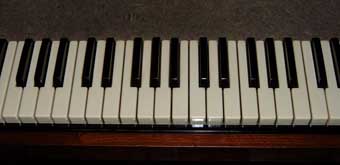
I finally turned my attention to the generator chassis and spend a day working on the preamp chassis that contains the dreaded bitumen potted decoupling capacitors.
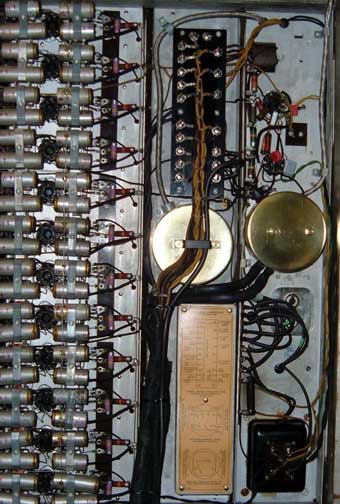
Although I have set myself the challenge of retaining as much as I possibly could there was no way I was going to risk not replacing any component in a direct low impedance path of the power supply. This meant that all decoupling capacitors had to be replaced. Any cap that has been retained has at least one resistor in series with the PSU and thus, if one does decide to fail short circuit, then hopefully, all that will happen is one resistor may overheat as opposed to the entire PSU going up again! I also took the liberty to fit a couple of fuses to the PSU chassis and mains input. The mains cord was replaced with a lovely modern replica cloth covered three core chord that permitted me to safely earth the chassis. To my horror, the original design, although isolated, made use of a capacitor from the neutral wire to the chassis which means that if this either failed or the plag was reversed in the mains socket there was a good chance then entire chassis would become live! Needless to say this cap was removed.
There has been a lot of rumour and myth spread about the Novachord being full of dreaded PCB oil and other poisonous substances. After careful inspection and research it turns out that the vast majority of capacitors in the Novachord are no more than paraffin wax, foil and paper construction. This explains partly why the Novachord gained a reputation for being rather prone to drifting out of calibration with changes in humidity and temperature. There are three PCB oil caps in the Novachord - one in the PSU, one in the preamp and one in the PA chassis. The irony is that these are clearly high quality components and read remarkably close to their specified values with no sign of any oil leakage. At the other end of the spectrum, the two rectangular potted multicaps in the preamp are horrible and must have been the cause of many a failed Novachord. Having been reliably informed that these are nothing more than bitumen filled I removed them and went outdoors to have some fun with a hot air gun. Taking some care, and being careful not to breath the revolting smoke, I set about melting the bitumen in order to scoop out their disgusting contents and rescue the original casings. This worked remarkably effectively and in a couple of hours I had two shiny casings on one side and a baked bean can full of tar and dead capacitors on the other. I spent the next day meticulously wiring up and sleeving new polyester capacitors ready to be potted in the original casings using two part black resin. These cured in the oven and were fitted the following day. Having sleeved the bright red PTFE wiring with black heat shrink and refitting the caps you would never know they were replaced!
To my delight and amazement the Novachord features a centre tapped audio output transformer running at near line levels. This was originally used to drive the power amplifier without the need for a phase splitter and, as modern balanced line outputs work, acted to cancel any induced common mode noise. This was gift as the output arrangement could be easily modified to act as a safe, isolated, balanced line output. I fitted a high quality balanced cable to the transformer outputs and fed this off to the back panel where I fitted a modern XLR output socket on a solid aluminium angle plate. The Novachord was designed from day one to drive external sources and there is even an internal configuration terminal to disable the negative feedback path from the discarded PA chassis.
By this point two other Novachord experts had told me that the original PA chassis and speakers fitted in the cabinet where really loud but really rather poor quality. I was advised that it therefore might not be worth the trouble of restoring these units as a priority as they colour the sound so heavily and don't permit direct electrical recordings. All of the vintage recordings were made using microphones and they tend to reveal a very "honky" nature. It was only really when I heard Phil Cirocco's unit in action that I realised that the PA must have just slaughtered what turns out to be many KHz of audio response well above what I was expecting. In fact, it was only when I finally got #346 going that I realised just how massive the frequency range is when tapped directly from the preamp considering this is a 70 year old electronic instrument!!
After well over 200 hours of intense work, I reached that unforgettable day of gently powering up the beast for the first time in the UK. I wasn't taking any chances. I had a RCD feeding an isolation transformer feeding a variac via an emergency stop button! Even the heater transformer was being driven by a separate autotransformer so I could heat up all 146 tubes in the generator chassis prior to slowly applying the voltage to the high tension supply. There I was sitting there in front of the beast with my heart pounding away, the amplifier on, all 146 heaters glowing away and my hand ready to slowly wind up the power. I have to say I was petrified - I never have, nor am I ever likely to again - power up such a massive tube based design in my life!! With one eye on my multimeter attached to the 270V DC rail I started to wind up the variac. I got to about 30% and noticed that suddenly the HT rail was going negative!! I panicked and shut everything off wondering what on earth I had got wrong. After what seemed like hours of checking things it dawned on me that maybe this is just the effects of a complex split rail PSU coming up in sequence. I took an educated gamble and tried again. This time I wound the variac a little higher and for longer and, all of a sudden, the voltage swung positive and started climbing rapidly. I madly dived for a key with one foot hovering over my emergency stop button... 60 volts, 70 volts, 90 volts, 140 volts and suddenly out of my speakers comes a squawk, the imfamous ticking sound of the 6 channel vibrato starting up, 180 volts, 220 volts and, oh my lord!, notes are playing! The HT stabilised at 275 volts and there I was playing notes up and down the scales. They were horribly out of tune and like a crazy man with one foot still over the stop button, I dived for the tuning chokes and quickly tweaked all 12 working oscillators to roughly be in tune. It was only then, to my sheer delight, that I realised that almost the entire top 4 octaves were working. This is almost unheard of during a Novachord restoration and was a very lucky break indeed.
From this point I slowly gained more confidence with the instrument and ran her up for longer and longer periods. The rebuilt PSU was running remarkably cool and to my amazement, even the generator chassis, despite its mammoth 146 tubes, runs remarkably cool too.
There was a little too much mains hum and so I removed the PSU chassis and added some more smoothing capacitors. This time I was able to achieve 500mV ripple which is superb for a tube PSU producing 270V DC!
As the days went by I managed to restore more and more of her to operating condition leaving me with an almost original instrument operating fully with the exception of the bottom octave or so of notes which, due to the cumulative effects of slight miscalibration throughout the octaves has rendered them inoperative until I can perform a full calibration.
It was at this stage I started making my first demo recordings. The demo montage than many have heard ('Novachord Noodles') was taken only hours after initial powerup. Believe me, you haven't experienced making a recording from a vintage synth until you've played one literally with one eye watching the HT supply voltage on the multimeter for signs of dipping or surging whilst hovering your foot over an emergency stop button and keep the other eye out for smoke!!! To this day it still amazes me I managed to make these demos as palatable as they are considering the circumstances!
